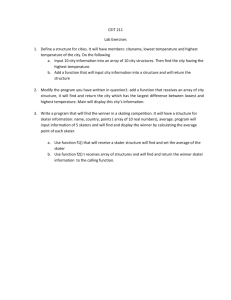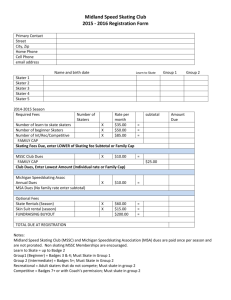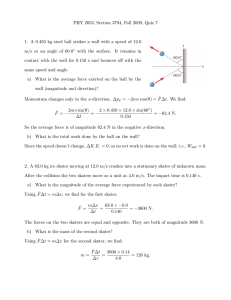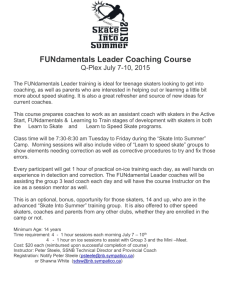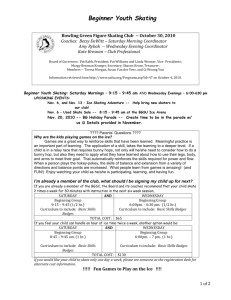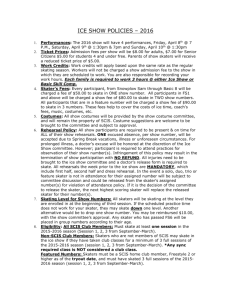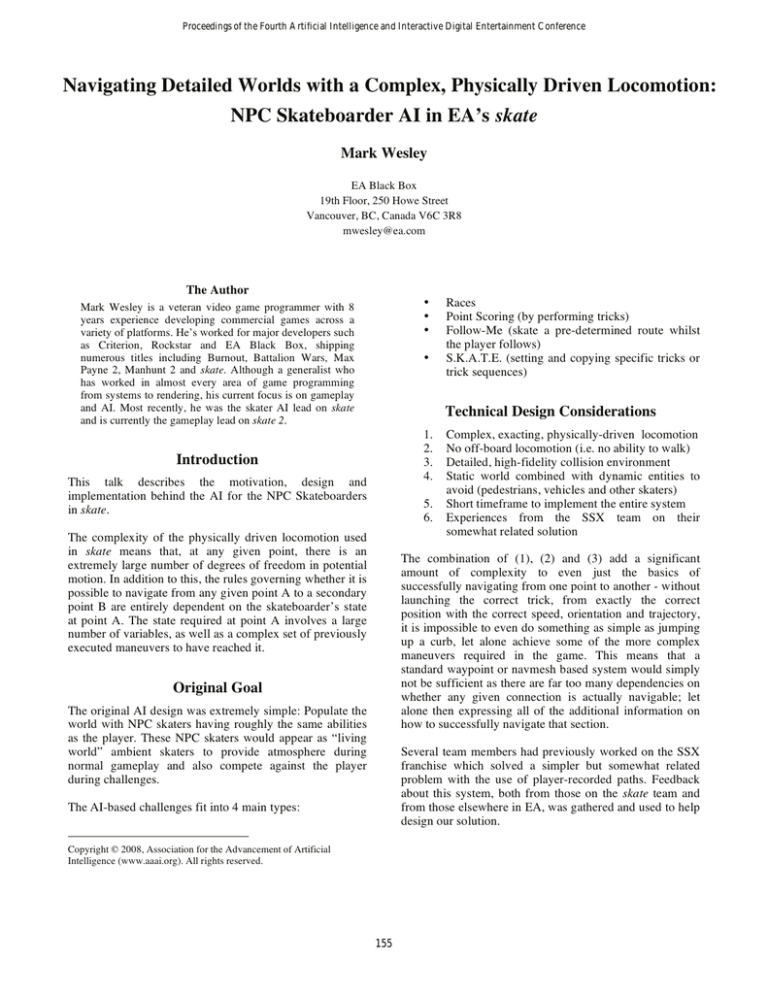
Proceedings of the Fourth Artificial Intelligence and Interactive Digital Entertainment Conference
Navigating Detailed Worlds with a Complex, Physically Driven Locomotion:
NPC Skateboarder AI in EA’s skate
Mark Wesley
EA Black Box
19th Floor, 250 Howe Street
Vancouver, BC, Canada V6C 3R8
mwesley@ea.com
The Author
•
•
•
Mark Wesley is a veteran video game programmer with 8
years experience developing commercial games across a
variety of platforms. He’s worked for major developers such
as Criterion, Rockstar and EA Black Box, shipping
numerous titles including Burnout, Battalion Wars, Max
Payne 2, Manhunt 2 and skate. Although a generalist who
has worked in almost every area of game programming
from systems to rendering, his current focus is on gameplay
and AI. Most recently, he was the skater AI lead on skate
and is currently the gameplay lead on skate 2.
•
Races
Point Scoring (by performing tricks)
Follow-Me (skate a pre-determined route whilst
the player follows)
S.K.A.T.E. (setting and copying specific tricks or
trick sequences)
Technical Design Considerations
1.
2.
3.
4.
Introduction
This talk describes the motivation, design and
implementation behind the AI for the NPC Skateboarders
in skate.
5.
6.
The complexity of the physically driven locomotion used
in skate means that, at any given point, there is an
extremely large number of degrees of freedom in potential
motion. In addition to this, the rules governing whether it is
possible to navigate from any given point A to a secondary
point B are entirely dependent on the skateboarder’s state
at point A. The state required at point A involves a large
number of variables, as well as a complex set of previously
executed maneuvers to have reached it.
Complex, exacting, physically-driven locomotion
No off-board locomotion (i.e. no ability to walk)
Detailed, high-fidelity collision environment
Static world combined with dynamic entities to
avoid (pedestrians, vehicles and other skaters)
Short timeframe to implement the entire system
Experiences from the SSX team on their
somewhat related solution
The combination of (1), (2) and (3) add a significant
amount of complexity to even just the basics of
successfully navigating from one point to another - without
launching the correct trick, from exactly the correct
position with the correct speed, orientation and trajectory,
it is impossible to even do something as simple as jumping
up a curb, let alone achieve some of the more complex
maneuvers required in the game. This means that a
standard waypoint or navmesh based system would simply
not be sufficient as there are far too many dependencies on
whether any given connection is actually navigable; let
alone then expressing all of the additional information on
how to successfully navigate that section.
Original Goal
The original AI design was extremely simple: Populate the
world with NPC skaters having roughly the same abilities
as the player. These NPC skaters would appear as “living
world” ambient skaters to provide atmosphere during
normal gameplay and also compete against the player
during challenges.
Several team members had previously worked on the SSX
franchise which solved a simpler but somewhat related
problem with the use of player-recorded paths. Feedback
about this system, both from those on the skate team and
from those elsewhere in EA, was gathered and used to help
design our solution.
The AI-based challenges fit into 4 main types:
Copyright © 2008, Association for the Advancement of Artificial
Intelligence (www.aaai.org). All rights reserved.
155
The Chosen Solution – Player Recorded AI
Paths
All recording functionality was available from a simple set
of in-game menus. Existing debug rendering support was
used to draw the paths as they were being recorded or
edited.
Given the considerations above, especially the time
constraint, the somewhat tried and tested method of
recording player paths was chosen. On top of this it was
necessary to add various dynamic elements like branching,
dynamic obstacle avoidance, trick-swapping and wipeouts,
which would allow modification of the runtime behavior as
required and add variety.
Whilst recording a path, nodes were placed at various
intervals behind the player. The decision of when to place
the next node was determined by calculating the error
between a high detailed recording of the player (with a
node stored from every frame of the last few seconds) with
the interpolated data that would be produced between this
frame and the last node placed. As soon as the error at any
frame exceeded some predefined thresholds then a node
would be placed. On average, this resulted in one node
being placed every 15 frames.
AI Path Recording
AI paths were generated by simply recording the player
skating around the world. The paths recorded the “what
and where” (e.g. position, orientation, speed and trick
performed) rather than the “how” (e.g. controller inputs) so
that we did not have to rely on determinism – the
advantages being that it was then possible to diverge from
a path as necessary at runtime for avoidance and it also
coped with any minor changes in physics, animation and
collision geometry during development.
Rather than linear interpolation of the position, a Hermite
curve was used (using the position and velocity at each
node). Board and skater orientations were slerped, and the
velocity was re-computed back from the positional
Hermite curve rather than being interpolated.
Path widening was achieved as an automated off-line
process where the collision geometry and surface gradient
was evaluated on each side of the skater’s recorded path to
determine how far left and right the skater would be able to
diverge from the path and still be able to skate sensibly.
AI Path Data Structure
Nodes were sampled at discrete points and each contained:
1.
2.
Position
Velocity (observed rather than internal velocity
from physics) - used for both the Hermite curve
approximation and for calculating the expected
velocity at any point
Board orientation
Skater orientation
Time since the last placed node
Path width (how far the skater could stray to the
left or right of this point and still be able to safely
skate this path)
Some additional states, like whether the skater
was crouching or if the board was flipped
Once created, AI paths could then be: loaded, edited, saved
and deleted; all from within the game.
Extended Node data – This was only present for all starttrick nodes, and at the start of all air trajectories. It did not
exist for all other nodes (to save memory).
All path-editing operations (including path creation,
renaming and deletion) would, on confirmation, save the
relevant data onto the game console (in an intermediate
XML format).
3.
4.
5.
6.
7.
1.
2.
3.
4.
The path naming used a simple set of menus for selecting
the exact path type. For ambient paths, it would generate
the name as a GUID (so that multiple people could
seamlessly work on ambient paths across the world). For
challenge paths, it would automatically generate a path
name using a standardized naming convention for the
challenges.
Source Control
Trajectory (position and velocity)
Pitch (whether the skater performed a front or
back flip)
Yaw (how many degrees the skater spins)
Trick (which trick was performed)
Committing these changes into our source control system
was then achieved by running one small customized
command-line tool which would automatically generate a
change-list containing all relevant Add, Delete and Edit
operations.
Each element was stored in a memory efficient manner
(compressed vectors, compressed quaternions, quantized
structures, bit-flags, etc.), and everything was packed
together so that no memory was wasted on alignment.
Path Pre-Processing
To minimize runtime processing, all relevant path branches
were detected in an offline pre-processing step. This preprocessing step occurred in the tools pipeline, alongside
In Game Recording
156
the steps which converted the intermediate XML AI Path
data into its runtime binary representation. Paths for each
challenge were packaged together, and ambient paths were
injected into the world streaming data.
(for how likely they were to bail a given trick), and the
likelihood of them celebrating when they saw, or
performed, an impressive trick or trick sequence.
Trick Swapping
By default all builds of the game would load the binary
path resources. Ambient paths were streamed in and out
whilst skating around the world, and challenge paths were
loaded as one path package as part of the challenge
loading. However, XML path loading, combined with an
exact equivalent of the offline pre-processing, was present
in the non-final game builds to allow anyone (especially
the challenge designers) to work with the intermediate data
in an instant-feedback, zero-turnaround-time manner
whenever required – this could be enabled via a startup.ini
file, or toggled at runtime, and allowed the behavior of the
ambient path streaming and the challenge loading to be
toggled separately.
Whenever a trick node was encountered during path
following, the AI skater would determine whether to
follow the originally recorded trick, or if any of the other
tricks could be performed instead (based on a heuristic,
using such elements as the trick’s duration and whether it
landed into another trick). The chosen trick would depend
on the skater’s profile along with their challenge objectives
(e.g. they would always choose the required trick in a game
of S.K.A.T.E. when copying the player’s trick, whereas an
ambient skater would pick a trick at random based on the
weightings in their profile).
Wipeouts and Path Resetting
AI Path Following
When landing, the AI would determine (based on their
profile) if they should wipeout. In addition to these forced
wipeouts, they would occasionally bail directly from
collisions and physical constraints. Whenever the AI
detected that a skater was stuck, and any attempts to unstick them by analyzing potential alternative routes had
failed, they were wiped-out as a last ditch “catch-all”
solution.
The runtime path following primarily consisted of the
following steps:
1.
2.
3.
4.
5.
6.
Evaluating where the skater was relative to their
current path (also detecting if the skater had
somehow become stuck).
Evaluating any nearby dynamic obstacles
Evaluating any path branches (and potentially
changing their path)
Choosing the safest route to avoid obstacles
Choosing the controller intents necessary to
achieve the desired goal (turn, push, crouch,
brake, perform trick, etc.)
Passing the desired result data to physics
(allowing the physics to constantly apply a very
small blend to position, orientation and velocity to
keep the skater on the intended route)
Rubber Banding
During race and follow-me challenges, the AI skaters were
subject to some subtle rubber banding to help with
balancing. The rules of which were quite straightforward
and all relevant values were designer-tunable:
1.
2.
Branching
Path branching was achieved using the branch data built
into the path during the pre-processing step. Path selection
at branches (and path ends) was done using a heuristic
which favored the least obstructed, easiest to get to path
combined with a random factor to add variety. Scoring
potential, compared to the current desired points, as well as
trick potential, was also be evaluated in certain trick-based
game modes.
3.
Any AI Skaters that were ahead of the player were
slowed down, the amount of slowdown blending
smoothly from nothing, to full slowdown
depending on how far ahead they were.
Any AI Skaters that were behind the player were
sped up, the amount of speedup blending
smoothly from nothing, to full speedup depending
on how far behind they were.
Whenever the player was wiping-out, all AI
skaters would slow down to their full slowdown
speed.
Avoidance
For the pre-recorded paths to work correctly in a dynamic
world, with pedestrians, vehicles and other skaters, it was
necessary for dynamic avoidance to be combined with the
basic path following.
AI Character Profiles
Each skater’s profile was tuned by the game designers in
skate’s existing attribute editor. Tunable elements included
the skater’s speed, trick weightings (for how likely they
were to perform a specific trick), trick landing percentages
The avoidance system worked by evaluating all relevant
dynamic objects near to the player. Their estimated current
157
and future effect on the AI’s path was determined, and
potential solutions were evaluated.
NPCs and excluding any characters which were still
currently locked in the progression system.
•
When skating on a widened path section, the combination
of all occluded segments of the path was subtracted from
the navigable path data, and the center of the optimum
navigable segment was chosen as the candidate destination
(assuming that the path was not fully obstructed).
If no navigable segment was found (e.g. the skater was on
a narrow path section), then possible speeds were
evaluated for passing ahead or behind the set of obstacles.
If avoiding a collision was not possible, then the skater
would attempt to stop and/or potentially look for another
path.
To add variety, the characters used by the ambient
NPC skaters were rotated. Whenever 1 of the 3
possible AI skater models was not being used, it
was optionally unloaded and swapped for a new
model (depending on various elements such as how
many times it has been used, and which models
were currently usable).
To help populate the entire world with ambient paths, the
challenge design team was briefly assisted by a number of
skate’s QA testers – they helped to rapidly fill the world
with the necessary AI path data once the world geometry
was locked down.
Simulating Out-Of-World Skaters
Automated testing
As only the world surrounding the player was loaded, it
was entirely possible for an AI skater to be skating in part
of the world that was not currently loaded. This was
especially true in challenges that spread over a large area,
like the race challenges.
Due to the architecture of the AI system, it was trivial to
attach and remove an AI controller from any skater in the
game. Attaching an AI controller to the player was used
throughout development as a rapid means of testing and
iterating on AI features within a minimal environment.
To prevent the AI skaters falling out of the world in this
case, whenever they were outside of the streamed-in world
they had their normal physics disabled and were instead
simply dragged along the AI path network at the desired
speed (based on a combination of the recorded path speed
and the skater’s speed setting in their profile).
A simple automated stress / soak test was integrated into
the game using the player-controllable AI which would
make the player skate freely around the world using any
available path data. Any blocking front-end screens were
automatically skipped during this, and it was, therefore,
trivially easy to leave any build running as if being played
solidly all night. This provided a relatively realistic ingame soak test where systems such as the world streaming
and physics were being exercised constantly.
Ambient Skaters
For the most part, the ambient AI skaters simply used the
existing skater AI support, but there were a few additional
features:
•
All ambient paths were streamed with the world
(rather than being loaded by the relevant challenge).
•
Ambient skater spawning was based simply on
whether there was a currently loaded AI Path that
started between the given minimum and maximum
spawn distances around the player. Only 3 ambient
skaters were ever allowed in the world at any time.
•
Ambient skater un-spawning occurred whenever an
ambient skater was further away from the player
than a given un-spawn distance (this distance was
further than the maximum spawn distance, to
prevent them repeatedly spawning and un-spawning
on the un-spawn boundary).
•
Hooks for using the player-controllable AI were also
provided to the automated testing team, with the vision of a
specific set of paths and scripts being built to perform a
completely automated play-through of the game.
Various functional tests were built alongside the
development of the AI to prove that various features
worked. These proved very useful not only for building the
system and providing a reference implementation to any
customers of the system, but also for catching when any
part of the AI system was broken by another external
system.
Statistics from the final version of skate
The following table shows some statistics from the AI path
data used in the final version of skate:
On spawning, the model and character profile for
each ambient skater was chosen at random from the
currently loaded character models which were not
currently being used for either skaters or other
Total number of Paths
Total number of Nodes
Total number of Tricks
Total number of Branches
158
4,825
250,747
20,515
48,500
Total length of paths
Total duration of paths
Total memory (if all paths were
loaded simultaneously)
465 Km
17.5 Hours
12.68 MB
These were made up of 3,350 ambient (streamed) paths,
and 1,475 challenge paths.
To put the total path length (465 Km) in perspective – that
is equivalent to skating from Vancouver to Seattle and
1
back, followed by 11 runs down Mount Everest.
Note: Only the ambient paths in the streamed area around
the player (generally between about 500 to 750 KB), along
with the paths for the current active challenge (generally
between about 50 and 200KB), were ever in memory at a
given point, fitting within the 1 MB budget for the entire
Skater AI system. This represented 0.2% of the available
512MB of memory on our target platforms.
Conclusion
Overall, the path recording system worked well. In
addition to enabling the challenge designers to script
specific behaviors for each challenge, it also provided a
relatively simple way of collecting a large amount of
general skating data for the ambient skaters to provide
atmosphere during normal gameplay.
"Playing solo in the career mode won't leave you
feeling lonely. San Vanelona is somewhat of a haven
for skaters; they flock there... You'll be doing a
challenge and someone might cut in and skate your
line. Or you'll be hunting for a new spot to skate and
have P-Rod ride past you. These appearances are
common, but not superficial. You can follow
Rodriguez around town, which may lead you to a
sweet spot that you didn't know about… (90%)” (IGN
Review, 2007)
References
EA Canada. 2003. SSX 3. EA Sports BIG. (Video Game)
EA Canada. 2005. SSX On Tour. EA Sports BIG. (Video
Game)
IGN. 2007. skate Review. Retrieved September 7, 2007,
from the World Wide Web:
http://xbox360.ign.com/articles/818/818832p3.html
1
Based on distance from Vancouver to Seattle being 185
Km, and height of Mt. Everest being 8.8 Km.
159

